
The Enchanting Heart of Sucre: Historic Center
Discover the timeless charm and rich history of Sucre's Historic Center, a UNESCO World Heritage site brimming with colonial architecture, cultural landmarks, and local flavors.
Step back in time as you wander through the Historic Center of Sucre, Bolivia. This picturesque neighborhood, often referred to as the 'White City,' is a UNESCO World Heritage site. Its whitewashed buildings, colonial architecture, and cobblestone streets transport you to a bygone era, making it a must-visit for history buffs and culture enthusiasts. Start your journey at the Plaza 25 de Mayo, the city's main square, which is surrounded by some of Sucre's most iconic landmarks. Here, you will find the Metropolitan Cathedral, with its impressive facade and intricate interior, and the House of Freedom, where Bolivia's declaration of independence was signed. The square is also a great place to relax, people-watch, and soak in the local atmosphere. Don't miss a visit to the Recoleta, a hilltop convent offering panoramic views of the city. The climb might be a bit steep, but it's well worth the effort. Along the way, you'll pass by charming cafes and artisan shops, perfect for a quick break or souvenir hunting. For museum lovers, the ASUR Indigenous Art Museum provides fascinating insights into the region's indigenous cultures and their artistic traditions. The Historic Center is also a culinary delight. Indulge in traditional Bolivian dishes at one of the many local eateries. Be sure to try the salteñas, a type of savory pastry, and sip on some api, a warm, spiced corn drink. The vibrant Mercado Central is another highlight, offering fresh produce, local delicacies, and an authentic taste of daily life in Sucre.
Local tips in Historic Center
- Wear comfortable walking shoes; the cobblestone streets can be uneven.
- Visit early in the morning or late afternoon to avoid the midday heat.
- Carry local currency; not all places accept credit cards.
- Take a guided tour to fully appreciate the historical significance of the landmarks.
- Stay hydrated and use sunscreen, as the altitude can make the sun more intense.
The Enchanting Heart of Sucre: Historic Center
Step back in time as you wander through the Historic Center of Sucre, Bolivia. This picturesque neighborhood, often referred to as the 'White City,' is a UNESCO World Heritage site. Its whitewashed buildings, colonial architecture, and cobblestone streets transport you to a bygone era, making it a must-visit for history buffs and culture enthusiasts. Start your journey at the Plaza 25 de Mayo, the city's main square, which is surrounded by some of Sucre's most iconic landmarks. Here, you will find the Metropolitan Cathedral, with its impressive facade and intricate interior, and the House of Freedom, where Bolivia's declaration of independence was signed. The square is also a great place to relax, people-watch, and soak in the local atmosphere. Don't miss a visit to the Recoleta, a hilltop convent offering panoramic views of the city. The climb might be a bit steep, but it's well worth the effort. Along the way, you'll pass by charming cafes and artisan shops, perfect for a quick break or souvenir hunting. For museum lovers, the ASUR Indigenous Art Museum provides fascinating insights into the region's indigenous cultures and their artistic traditions. The Historic Center is also a culinary delight. Indulge in traditional Bolivian dishes at one of the many local eateries. Be sure to try the salteñas, a type of savory pastry, and sip on some api, a warm, spiced corn drink. The vibrant Mercado Central is another highlight, offering fresh produce, local delicacies, and an authentic taste of daily life in Sucre.
Iconic landmarks you can’t miss
Parque Cretácico
Explore Parque Cretácico in Sucre, Bolivia - an exciting blend of amusement and education featuring life-sized dinosaurs and engaging exhibits.
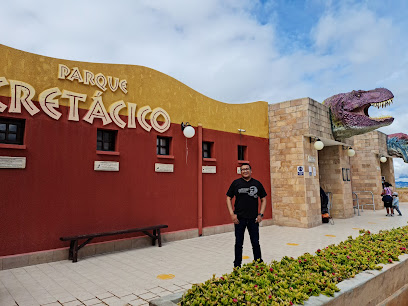
Freedom House
Explore Bolivia's independence journey at Freedom House, a national museum filled with history, culture, and captivating exhibits in Sucre.
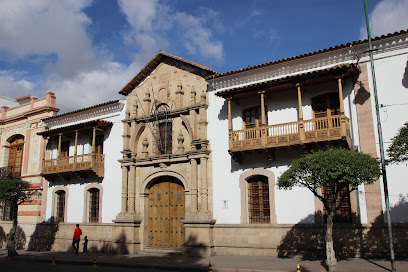
Glorieta Castle
Explore the enchanting Glorieta Castle in Sucre, a stunning historical landmark surrounded by beautiful gardens and breathtaking views.

Plaza de Armas 25 de Mayo
Explore the vibrant culture and history at Plaza de Armas 25 de Mayo, Sucre's iconic square filled with charm, architecture, and local festivities.

Treasure Museum
Explore the Treasure Museum in Sucre, Bolivia, and unearth the captivating history of mining and precious metals in the heart of South America.

Florida Mansion
Explore the Florida Mansion in Sucre, a stunning museum showcasing Bolivia's rich cultural heritage and architectural beauty.

Museo de Arte Indígena
Explore the vibrant history and artistry of Bolivia's indigenous cultures at the Museo de Arte Indígena in Sucre, a must-see for cultural enthusiasts.

La Rotonda
Discover the tranquil beauty of La Rotonda, a serene park in Sucre, Bolivia, perfect for relaxation and cultural exploration amidst lush landscapes.

La Galeria
Explore La Galeria in Sucre, a historical treasure reflecting Bolivia's vibrant culture and architectural beauty, perfect for history lovers and explorers.

Plaza 25 de Mayo
Explore the vibrant Plaza 25 de Mayo in Sucre, Bolivia, a historic hub filled with colonial architecture, local cuisine, and artisan markets.
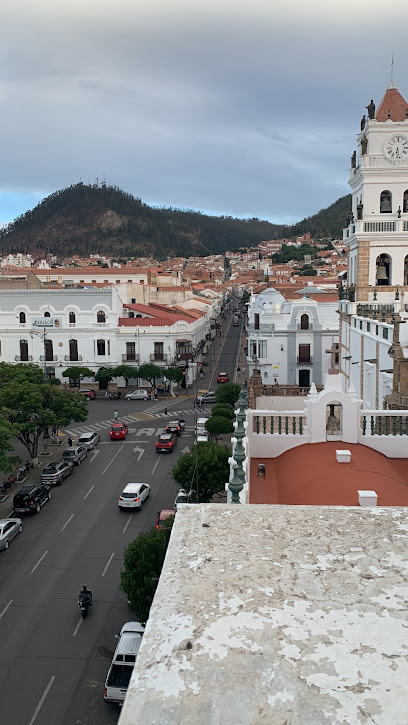
Unmissable attractions to see
Florida Mansion
Discover the rich history and stunning architecture of Florida Mansion, a premier tourist attraction and museum in Sucre, Bolivia.
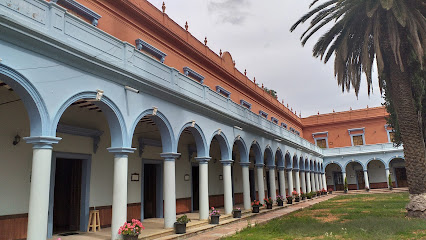
Museo del Convento de Santa Clara
Explore the rich history and serene beauty of Museo del Convento de Santa Clara, a cultural gem in Sucre, Bolivia.

Pasillo de artesanías de Sucre Bolivia
Discover the vibrant artisan market of Pasillo de Artesanías in Sucre, Bolivia, where culture and craftsmanship come alive.

Essential places to dine
Joy Ride Cafe
Discover culinary delights at Joy Ride Cafe in Sucre – where local flavors meet international flair in an inviting atmosphere.

Cosmo Café Restaurant
Experience exquisite dining at Cosmo Café Restaurant in Sucre - where local flavors meet fine dining in an inviting atmosphere.

Pueblo Chico
Experience the rich flavors of Bolivia at Pueblo Chico – a grill and dessert haven in Sucre with live piano music.

Cafe Restaurant Florin
Discover Cafe Restaurant Florin in Sucre: A unique blend of Dutch and Bolivian flavors awaits you at this cozy eatery.

La Taverne Sucre
Experience the essence of France at La Taverne Sucre, where exquisite cuisine meets warm hospitality in Bolivia's charming capital.

El Huerto
Discover the flavors of Bolivia at El Huerto – where tradition meets innovation in every bite.

Café Restaurant Potocchi Sucre
Experience the authentic flavors of Bolivia at Café Restaurant Potocchi Sucre - where every meal is a celebration of local culinary traditions.

La Culta
Experience authentic Bolivian flavors at La Culta in Sucre – a culinary haven for food lovers.

Foresta Restaurante
Experience the essence of Bolivian cuisine at Foresta Restaurante - where tradition meets taste in Sucre.

Dining Experience
Discover the authentic taste of Bolivia in Sucre's charming dining spot offering traditional dishes and a cozy ambiance.

Markets, malls and hidden boutiques
Mercado Central
Experience the vibrant Mercado Central in Sucre, where local flavors, crafts, and a lively atmosphere create an unforgettable cultural experience.

Freedom House
Explore Bolivia's rich history of independence at Freedom House, a national museum that showcases the nation's struggle and cultural heritage.
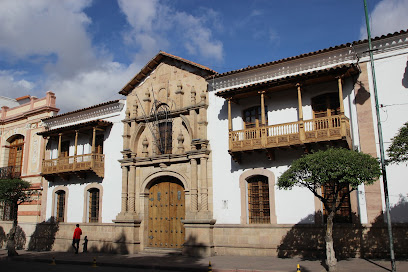
Museo de Arte Indígena
Explore the vibrant heritage and artistry of Bolivia at the Museo de Arte Indígena in Sucre, a cultural gem for every traveler.

Galería Arte y Cultura Sucre
Explore the vibrant art scene at Galería Arte y Cultura Sucre, a cultural hub showcasing Bolivian creativity through art, antiques, and jewelry.

Alpaca Andina
Discover unique Bolivian souvenirs at Alpaca Andina, Sucre's premier gift shop celebrating local craftsmanship and culture.
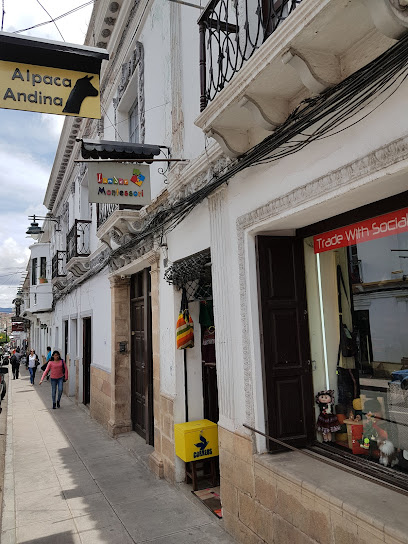
Shopping Florencia
Explore Shopping Florencia in Sucre: Your ultimate destination for shopping, dining, and experiencing Bolivian culture.

Purpose Tienda de regalos Sucre
Explore Purpose Tienda de regalos in Sucre for authentic Bolivian crafts and unique souvenirs, capturing the essence of your travel experience.

Mayis Store
Explore the vibrant Mayis Store in Sucre for unique gifts, fashion accessories, and enchanting magical items that capture the spirit of Bolivia.

Pasaje Comercial Sucre
Explore the vibrant fashion scene at Pasaje Comercial Sucre, where local culture meets modern style in the heart of Bolivia's historic city.

Bolivian Textiles Gallery Artesania en Gral.
Explore the Bolivian Textiles Gallery Artesania en Gral. in Sucre: A vibrant showcase of traditional crafts and rich cultural heritage.

Fenix Store Sucre
Experience shopping like never before at Fenix Store Sucre, where local culture meets modern retail in a vibrant atmosphere.
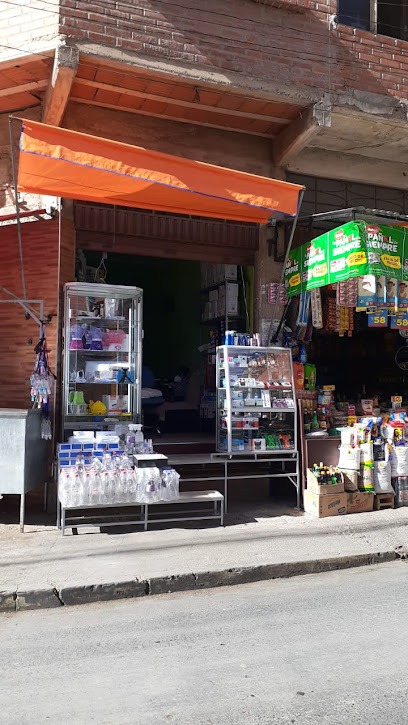
BRUMAT, Sucre, Bolivia
Discover the essence of Bolivia at BRUMAT, a charming gift shop in Sucre filled with unique, handmade crafts and local treasures.

COTTI SHOP SUCRE
Explore unique Bolivian fashion at Cotti Shop Sucre, where local craftsmanship meets contemporary style in a delightful shopping experience.

Essential bars & hidden hideouts
Joy Ride Cafe
Experience the vibrant culinary scene of Sucre at Joy Ride Cafe, where local flavors meet international cuisine in a cozy atmosphere.

CAVENDISH Resto - Bar
Experience the vibrant flavors of Sucre at CAVENDISH Resto - Bar, where delicious grilled dishes and a lively atmosphere await you.

GOBLIN Bar y cervecería artesanal de la casa
Discover the vibrant atmosphere of GOBLIN Bar, Sucre's premier craft beer destination, where artisanal brews and local culture come together.
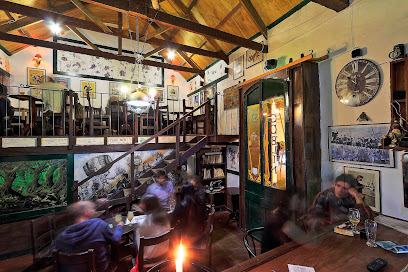
Tabacos Soul Anexo
Experience the vibrant nightlife of Sucre at Tabacos Soul Anexo, where every night is a karaoke celebration filled with music and laughter.

ROCKERZ HARD ROCK CAFE
Discover the heart of Sucre's nightlife at Rockerz Hard Rock Cafe—where live music, delicious food, and vibrant culture meet.

búhoBAR
Discover vibrant nightlife at búhoBAR, the ultimate spot for drinks, dancing, and socializing in the heart of Sucre, Bolivia.

Reset Bar Sucre
Discover the best nightlife in Sucre at Reset Bar, where great food, drinks, and karaoke come together for an unforgettable experience.

BeerCat Café Concert
Discover the lively atmosphere of BeerCat Café Concert, a must-visit bar in Sucre, offering local brews and vibrant live music.

Old menfis Bar
Discover the essence of Sucre's nightlife at Old Menfis Bar, where vibrant atmosphere meets expertly crafted drinks for an unforgettable experience.

EUROPUB HERACLES
Experience the vibrant nightlife at Europub Heracles in Sucre, where delicious food, refreshing drinks, and live music create unforgettable moments.

Local Phrases
-
- HelloHola
[OH-lah] - GoodbyeAdiós
[ah-DYOS] - YesSí
[SEE] - NoNo
[NO] - Please/You're welcomePor favor/De nada
[por fah-VOR/de NAH-dah] - Thank youGracias
[GRAH-syahs] - Excuse me/SorryPerdón
[pehr-DOHN] - How are you?¿Cómo estás?
[KOH-moh ehs-TAHS] - Fine. And you?Bien. ¿Y tú?
[BYEN. ee too] - Do you speak English?¿Hablas inglés?
[AH-blahs een-GLEHS] - I don't understandNo entiendo
[NOH ehn-TYEHN-doh]
- HelloHola
-
- I'd like to see the menu, pleaseMe gustaría ver el menú, por favor
[may goos-tah-REE-ah behr ehl meh-NOO, por fah-VOR] - I don't eat meatNo como carne
[NOH KOH-moh KAHR-neh] - Cheers!¡Salud!
[sah-LOOD] - I would like to pay, pleaseMe gustaría pagar, por favor
[may goos-tah-REE-ah pah-GAHR, por fah-VOR]
- I'd like to see the menu, pleaseMe gustaría ver el menú, por favor
-
- Help!¡Ayuda!
[ah-YOO-dah] - Go away!¡Vete!
[VEH-teh] - Call the Police!¡Llama a la policía!
[YAH-mah ah lah poh-LEE-see-ah] - Call a doctor!¡Llama a un doctor!
[YAH-mah ah oon dohk-TOHR] - I'm lostEstoy perdido
[ehs-TOY pehr-DEE-doh] - I'm illEstoy enfermo
[ehs-TOY ehn-FEHR-moh]
- Help!¡Ayuda!
-
- I'd like to buy...Me gustaría comprar...
[may goos-tah-REE-ah kohm-PRAR] - I'm just lookingSólo estoy mirando
[SOH-loh ehs-TOY mee-RAHN-doh] - How much is it?¿Cuánto cuesta?
[KWAHN-toh KWEHS-tah] - That's too expensiveEso es demasiado caro
[EH-soh ehs deh-mah-SYA-doh KAH-roh] - Can you lower the price?¿Puede bajar el precio?
[PWEH-deh BAH-har ehl PREE-syoh]
- I'd like to buy...Me gustaría comprar...
-
- What time is it?¿Qué hora es?
[keh OR-ah ehs] - It's one o'clockEs la una
[ehs lah OO-nah] - Half past (10)Siete y media
[SYEH-teh ee MEH-dyah] - MorningMañana
[mah-NYAH-nah] - AfternoonTarde
[TAHR-deh] - EveningNoche
[NOH-cheh] - YesterdayAyer
[ah-YEHR] - TodayHoy
[oy] - TomorrowMañana
[mah-NYAH-nah] - 1Uno
[OO-noh] - 2Dos
[dohs] - 3Tres
[trehs] - 4Cuatro
[KWAH-troh] - 5Cinco
[SEEN-koh] - 6Seis
[says] - 7Siete
[SYEH-teh] - 8Ocho
[OH-choh] - 9Nueve
[NWEH-veh] - 10Diez
[DYEHSS]
- What time is it?¿Qué hora es?
-
- Where's a/the...?¿Dónde está el/la...?
[DOHN-deh ehs-TAH ehl/lah] - What's the address?¿Cuál es la dirección?
[KWAHL ehs lah dee-rehk-SYOHN] - Can you show me (on the map)?¿Puedes mostrarme (en el mapa)?
[PWEH-dehs mohs-TRAHR-meh (ehn ehl MAH-pah)] - When's the next (bus)?¿Cuándo es el próximo (autobús)?
[KWAHN-doh ehs ehl PROH-ksee-moh (ow-toh-BOOS)] - A ticket (to ....)Un boleto (para ...)
[oon boh-LEH-toh (PAH-rah)]
- Where's a/the...?¿Dónde está el/la...?
History of Historic Center
-
Sucre, originally known as La Plata, was founded in 1538 by the Spanish conquistador Pedro Pizarro. Its strategic location in the heart of Bolivia made it a key site during the colonial period. The city was designed with a grid layout, and its Historic Center showcases well-preserved colonial architecture, reflecting Spanish colonial influences, including the stunning Cathedral of Sucre and the Casa de la Libertad, where Bolivia's independence was declared in 1825.
-
The Historic Center of Sucre was pivotal during the fight for independence from Spanish rule in the early 19th century. The city served as the political center for the revolutionaries and was the site of significant events, including the Battle of Ayacucho in 1824, which solidified Bolivia’s independence. The Casa de la Libertad, where key revolutionary meetings occurred, remains a symbol of this struggle.
-
Following independence, Sucre became the constitutional capital of Bolivia, leading to a cultural and educational renaissance during the 19th century. The establishment of the Universidad Mayor de San Francisco Xavier de Chuquisaca in 1624, one of the oldest universities in the Americas, contributed to the city’s reputation as a center of learning and culture, influencing the Historic Center’s vibrant intellectual life.
-
In 1991, the Historic Center of Sucre was declared a UNESCO World Heritage Site, acknowledging its exceptional colonial architecture and historical significance. The area features numerous public squares, churches, and government buildings that reflect a blend of indigenous and Spanish architectural styles. Notable structures include the Convento de San Felipe Neri and the Palacio de la Glorieta, showcasing the city’s rich cultural tapestry.
-
Today, Sucre’s Historic Center remains a vibrant hub of activity, with local markets, restaurants, and cultural events. Efforts to preserve the architectural integrity and cultural heritage of the area continue, supported by both local and international organizations. The Historic Center serves not only as a reminder of Bolivia’s past but also as a living space where traditions and modernity coexist.
Historic Center Essentials
-
The Historic Center of Sucre is easily accessible from other neighborhoods. If you’re coming from the airport, a taxi or shuttle service will get you there in about 30 minutes. Within the city, local buses and taxis are available, with the main bus terminal located near the Plaza 25 de Mayo, which serves as a central hub for connections to other neighborhoods.
-
The Historic Center is best explored on foot, as many of its attractions are within walking distance. Taxis are readily available for longer distances or if you prefer not to walk. Bicycles can be rented at various locations, and some hostels offer free bike rentals. There are no train services in the center, but local buses connect to peripheral areas.
-
While Sucre is generally safe for tourists, caution is advised, especially in less crowded areas. Areas around the bus terminal and certain outskirts may have higher crime rates, including petty theft. It is recommended to avoid walking alone at night and to keep valuables secure and out of sight.
-
In case of an emergency, dial 110 for police assistance and 118 for medical emergencies. The nearest hospitals are Hospital Santa Barbara and Hospital Universitario. It is advisable to have travel insurance that covers emergencies. Pharmacies are also available throughout the city for minor health issues.
-
Fashion: Do dress modestly, especially in religious sites; avoid shorts and sleeveless tops. Religion: Do respect local customs; when entering churches, it's customary to cover your shoulders and knees. Public Transport: Do be courteous; offer your seat to elderly passengers. Don't eat or drink on public transport. Greetings: Do greet locals with a handshake and a smile. Eating & Drinking: Do try local foods and drinks, especially Salteñas; don't refuse food offerings, as it can be seen as rude.
-
To experience the Historic Center like a local, visit the local markets such as Mercado Central for fresh produce and traditional snacks. Engage with locals in quieter cafes away from tourist spots for a more authentic experience. Try to participate in local festivals if your visit coincides with any, as they offer a glimpse into Bolivian culture and traditions.
Nearby Cities to Historic Center
-
Things To Do in Potosi
-
Things To Do in Cochabamba
-
Things To Do in Uyuni
-
Things To Do in Santa Cruz de la Sierra
-
Things To Do in Tarija
-
Things To Do in La Paz
-
Things To Do in Copacabana
-
Things To Do in San Pedro de Atacama
-
Things To Do in Iquique
-
Things To Do in Arica
-
Things To Do in Tacna
-
Things To Do in Puno
-
Things To Do in Salta
-
Things To Do in Arequipa
-
Things To Do in Antofagasta













